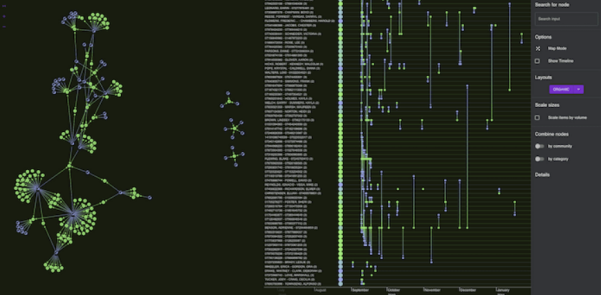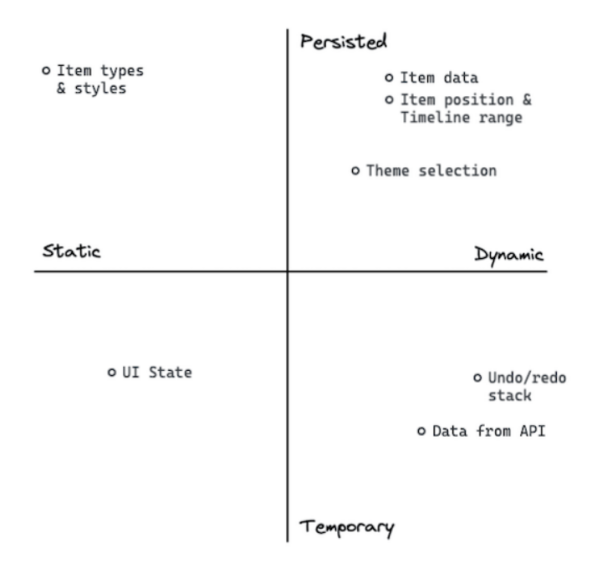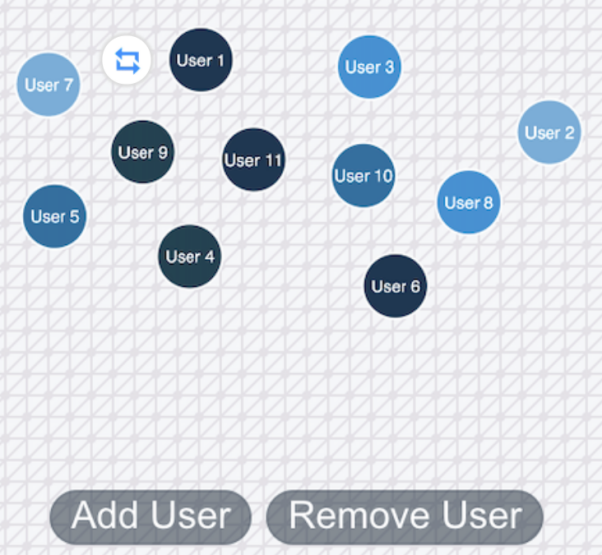【51CTO.com快译】如果您是一名React开发人员,那么一定对状态管理策略并不陌生。当我们在使用React去构建Web应用时,所有信息都被保存在所谓的状态之中。我们只需要更新该状态,即可实现对Web应用的更新。而状态管理,是指在应用程序的生命周期中,处理各种事件,并控制不同组件之间数据传递的过程。
一直以来,我们都习惯于使用针对JavaScript应用的、流行且强大的Redux库,作为状态容器。而React本身在其16.8版中已增加了Hooks。在本文中,我将根据自己在使用React SDK,构建生产级数据可视化工具过程中的经验,和您探讨这两种状态管理的方法,并介绍作为第三种方法的混合使用。
状态管理战略规划
首先,让我们来考虑状态管理的两个难题:需要存储什么状态,以及为什么要如此。毕竟,在数据可视化的应用中,并非所有状态都是相同的。
如下应用示例所示,我们希望通过图表中显示的节点和链接,以获悉当前的各个连接,以及与时间线组件共享的数据,进而甄别出数据集中的时间戳。其Sidebar包括了用于搜索和更新图表、及时间线的UI元素。简单而言,我们的目标就是实现如下图形和时间线的可视化。具体请参见--KronoGraph(。
在状态管理策略的规划阶段,我们可以通过在轴上绘制状态,以了解正在处理的具体内容:
如上图所示,我们在此所遵循的原则为:
- 条目类型:除非您正在构建一个通用应用,否则图表和时间线中的节点类型(如:人员、地点、车辆)都应当尽可能是静态的。由于我们可以提前定义它们,因此它们不需要带有状态,可以位于存储库的配置文件中。
- 条目样式:包含了每个节点和链接类型的核心样式,以及它们的预期逻辑。
- 主题选择:为用户提供了在暗模式与亮模式之间切换的选项,并通过该状态的变化,去跟踪用户的偏好。
- UI状态:UI状态包括静态和临时等。虽然我们没有必要在状态中,存储所有关于表单的交互,但是需谨防那些可能导致应用处于无响应状态的常见错误。
- 条目位置和时间线范围:网络中的节点位置可能并不固定:
- 在图表中,用户可以根据偏好进行布局,并手动定位节点。
- 在时间线中,用户可以放大其感兴趣的时间范围。
- 在不同的会话中,通过位置的保持,用户可以从上一次中断处继续。
- 撤消与重做栈:在高级应用中,我们需要通过设计,让用户能够在各自的当前会话中,保留撤消与重做数据的权限。
- 来自API的数据:功能强大的应用程序,需要将那些从外部端点或API接收来的、动态且临时的数据缓存起来,并保存它们在应用中的状态。
状态管理的方法
有了前面状态管理的规划,我们来考虑应用中的数据层次结构。目前,我们有三种主要的状态管理方法可供选择:
- 处理组件中的状态,并按需使用Hook在状态间进行传递。这种方法通常被称为“prop drilling”或“提升状态”,常被推荐用于基础类的应用。
- 使用某种全局存储,以便所有组件都可访问。Redux之类的库可以提供该功能。
- 使用混合方法,将Hook与那些经过慎重选择的重要状态相结合。
下面,让我们通过上述数据可视化的应用,来进一步探索这三种方法。
Redux状态管理
自2015年被发布以来,Redux已经成为了React生态系统的关键部分。它使用不变性(immutability)来简化应用程序的开发和逻辑设计。通过将处于某种状态的所有条目,强制设置为不变性,我们可以跟踪对于数据的任何更改,进而避免可能导致意外错误发生的数据突变。
虽然Redux目前仍是状态复杂的大型应用的绝佳选择,但是随着时间的推移,它变得日渐臃肿。为了协助降低其复杂性,Redux Toolkit于2019年应运而生,并成为了Redux的首推方式。
一致性的状态更新
Redux的一个核心概念是reducer。对于那些具有函数编程经验的人而言,这是一个能够接受多个输入,并将其减少为单个输出的函数。在状态管理中,该扩展能够让您通过采用一个或多个状态的更新指令,为图表生成一致性的状态更新。
让我们来考虑一个标准化的图形可视化用例:在图表中添加和删除节点。为了在全局存储中创建一个状态“切片”,我们在store.js中创建了如下代码:
JavaScript
import { configureStore } from '@reduxjs/toolkit';
import itemsReducer from '../features/chart/itemsSlice';
export const store = configureStore({
reducer: {
items: itemsReducer
}
});
- 1.
- 2.
- 3.
- 4.
- 5.
- 6.
- 7.
- 8.
为了让应用程序中的其他组件能够访问该存储,我们可以对应用程序进行如下“包装”:
JavaScript
importReactfrom 'react';
import ReactDOM from 'react-dom';
import './index.css';
import App from './App';
import { store } from './app/store';
import { Provider } from 'react-redux';
import * as serviceWorker from './serviceWorker';
ReactDOM.render(
<React.StrictMode>
<Provider store={store}>
<App />
</Provider>
</React.StrictMode>,
document.getElementById('root')
);
- 1.
- 2.
- 3.
- 4.
- 5.
- 6.
- 7.
- 8.
- 9.
- 10.
- 11.
- 12.
- 13.
- 14.
- 15.
- 16.
其中的Provider段意味着,其任何下游都可以访问该存储。在itemsSlice.js中,我们为各个条目定义了状态切片:
JavaScript
import { createSlice, createEntityAdapter } from '@reduxjs/toolkit';
export const itemsAdapter = createEntityAdapter();
const initialState = itemsAdapter.getInitialState();
export const itemsSlice = createSlice({
name: 'items',
initialState,
reducers: {
addItems: itemsAdapter.addMany,
addItem: itemsAdapter.addOne,
removeItems: itemsAdapter.removeMany,
removeItem: itemsAdapter.removeOne,
},
});
export const { addItems, addItem, removeItems, removeItem } = itemsSlice.actions;
export const { select, selectAll, selectTotal } = itemsAdapter.getSelectors((state) => state.items);
export default itemsSlice.reducer;
- 1.
- 2.
- 3.
- 4.
- 5.
- 6.
- 7.
- 8.
- 9.
- 10.
- 11.
- 12.
- 13.
- 14.
- 15.
- 16.
- 17.
- 18.
- 19.
- 20.
- 21.
通过上述代码段,我们可以获悉:
- ReGraph的条目是各种通过ID索引的节点和链接对象。其核心数据结构十分常见。Redux Toolkit会通过一些辅助函数,来处理此类格式数据。在此,我们用到了由createEntityAdapter提供的addMany、addOne、removeMany、以及removeOne等功能。
- 在Redux中,Selector允许我们从存储中获取一个状态片。我可以利用getSelectors适配器,来避免自行编写状态查询代码。
- 最后,我们导出所有内容,以便在应用程序的其他地方使用。
在应用的其他代码中,我们还用到了store、reducer和selectors:
JavaScript
import React from 'react';
import { useSelector, useDispatch } from 'react-redux';
import { Chart } from 'regraph';
import { addItems, addItem, removeItems, removeItem, selectAll, selectTotal } from './itemsSlice';
import mapValues from 'lodash/mapValues';
import styles from './NetworkChart.module.css';
const colors = ['#173753', '#6daedb', '#2892d7', '#1b4353', '#1d70a2'];
const defaultNodeStyle = (label) => ({
label: {
text: `User ${label}`,
backgroundColor: 'transparent',
color: 'white',
},
border: { width: 2, color: 'white' },
color: colors[(label - 1) % colors.length],
});
const styleItems = (items, theme) => {
return mapValues(items, (item) => {
if (item.id1) {
return { ...defaultLinkStyle(item.id), ...theme[item.type] };
} else {
return { ...defaultNodeStyle(item.id), ...theme[item.type] };
}
});
};
export function NetworkChart() {
const dispatch = useDispatch();
const items = useSelector(selectAll);
const itemCount = useSelector(selectTotal);
const theme = { user: {} };
const styledItems = styleItems(items, theme);
return (
<div className={styles.container}>
<Chart
items={styledItems}
animation={{ animate: false }}
options={{ backgroundColor: 'rgba(0,0,0,0)', navigation: false, overview: false }}
/>
<div className={styles.row}>
<button
className={styles.button}
aria-label="Add items"
onClick={() => dispatch(addItem({ id: itemCount + 1, type: 'user' }))}
>
Add User
</button>
<button
className={styles.button}
aria-label="Remove Items"
onClick={() => dispatch(removeItem(itemCount))}
>
Remove User
</button>
</div>
</div>
);
}
- 1.
- 2.
- 3.
- 4.
- 5.
- 6.
- 7.
- 8.
- 9.
- 10.
- 11.
- 12.
- 13.
- 14.
- 15.
- 16.
- 17.
- 18.
- 19.
- 20.
- 21.
- 22.
- 23.
- 24.
- 25.
- 26.
- 27.
- 28.
- 29.
- 30.
- 31.
- 32.
- 33.
- 34.
- 35.
- 36.
- 37.
- 38.
- 39.
- 40.
- 41.
- 42.
- 43.
- 44.
- 45.
- 46.
- 47.
- 48.
- 49.
- 50.
- 51.
- 52.
- 53.
- 54.
- 55.
- 56.
- 57.
- 58.
- 59.
- 60.
- 61.
- 62.
- 63.
- 64.
- 65.
- 66.
- 67.
通过使用Redux Hook的suseSelector,我们可以轻松利用切片代码,来提供选择器。同时,其useDispatch允许我们根据状态的“调度(dispatch)”动作(Redux的另一个实用部分),去变更状态。
使用Redux管理状态去添加和删除节点
Redux Toolkit使用时下流行的不变性库--Immer,对状态进行“纯净”地更新,而无需额外编写复杂的克隆和更新逻辑。在此,我们直接在组件中设置了图表项的样式。
当您从外部来源获取数据时,应用程序的状态和数据库的存储之间,很难被清晰地界定。与Redux Toolkit同源的RTK Query则通过与诸如react-query之类的库相配合,避免了从零开始编写缓存等功能。
如果您的应用单纯依赖Redux,那么可以将整个应用的状态放在全局存储中,以便每个组件都能访问它。当然,实际上只有某一些可视化组件的状态,需要通过Hooks和Redux的混合方法,实现存储。
Prop Drilling
著名的软件工程教育者--Kent C. Dodds曾提出了一个重要的观点:应保持状态尽可能地靠近需要的地方。对于上述示例,这意味着如果我们希望在图表和时间线组件之间共享数据,则可以通过Prop Drilling来简化并实现。这将是一种跨组件共享状态的有效且纯净的方式。也就是说,如果我们将状态带到VisualizationContainer应用中,则可以将数据作为prop传递到每个组件处。当然,如果我需要在复杂的层次结构中上下传递,则仍可以使用Redux。
凭借着其强大的API和一些精心设计的prop,ReGraph在控制其内部状态方面,非常有效。我们甚至不需要让过多的prop流转到图表的组件之外。
React Hooks
就示例中的图表组件而言,我们可以使用simpleuseState和useRefHooks,来处理状态中的基本配置。ReGraph可以将那些对于状态的多次更新处理,通过单独调用useState对方式来实现,进而免去了prop组的频繁更新。
JavaScript
const [layout, setLayout] = useState(defaults.layout);
setLayout({name: 'sequential'})
- 1.
- 2.
对于使用过Redux的人来说,Hook的useReducer以及如下代码段,一定不会陌生。
JavaScript
import React, { useState, useReducer, useCallback } from 'react';
const [combine, combineDispatch] = useReducer(combineReducer, defaults.combine)
const combineItems = useCallback(property => combineDispatch({ type: 'COMBINE', property }), [])
const uncombineItems = useCallback(property => combineDispatch({ type: 'UNCOMBINE', property }), [])
function combineReducer(combine, action) {
const newCombine = { ...combine };
if (action.type === 'COMBINE') {
newCombine.properties.push(action.property);
newCombine.level = combine.level + 1;
}
else if (action.type === 'UNCOMBINE') {
newCombine.properties.pop();
newCombine.level = combine.level - 1;
} else {
throw new Error(`No action ${action.type} found`);
}
return newCombine;
}
- 1.
- 2.
- 3.
- 4.
- 5.
- 6.
- 7.
- 8.
- 9.
- 10.
- 11.
- 12.
- 13.
- 14.
- 15.
- 16.
- 17.
- 18.
- 19.
- 20.
- 21.
值得注意的是,没有了Redux Toolkit的帮助,我们需要人工更新已组合的对象。这就意味着,更多的代码需要被编写。在上述ReGraph之类的小型应用示例中,我们手动编写了reducer。
React的useReducer与Redux中的reducer之间存在概念上的差异。在React中,我们编写了任意数量的reducer。它们只是各种便于更新状态的Hooks。而在Redux中,它们作为概念性的分离,以应对集中式的存储。
正如下面代码段所示,我们可以为ReGraph编写一个定制的Hook,来封装所有需要用到的prop:
JavaScript
import React, { useState, useReducer, useCallback } from 'react';
import { has, merge, mapValues, isEmpty } from 'lodash';
import { chart as defaults } from 'defaults';
const linkColor = '#fff9c4';
const nodeColor = '#FF6D66';
function isNode(item) {
return item.id1 == null && item.id2 == null;
}
function transformItems(items, itemFn) {
return mapValues(items, (item, id) => {
const newItem = itemFn(item, id);
return newItem ? merge({}, item, newItem) : item
});
};
function styleItems(items) {
return transformItems(items, item => {
return defaults.styles[isNode(item) ? 'node' : 'link'];
});
}
function itemsReducer(items, action) {
const newItems = { ...items };
if (action.type === 'SET') {
return { ...newItems, ...styleItems(action.newItems) }
}
else if (action.type === 'REMOVE') {
Object.keys(action.removeItems).forEach(removeId => { delete newItems[removeId]; })
return newItems;
} else {
throw new Error(`No action ${action.type} found`);
}
}
function combineReducer(combine, action) {
const newCombine = { ...combine };
if (action.type === 'COMBINE') {
newCombine.properties.push(action.property);
newCombine.level = combine.level + 1;
}
else if (action.type === 'UNCOMBINE') {
newCombine.properties.pop();
newCombine.level = combine.level - 1;
} else {
throw new Error(`No action ${action.type} found`);
}
return newCombine;
}
function useChart({ initialItems = {} }) {
const styledItems = styleItems(initialItems)
const [items, dispatch] = useReducer(itemsReducer, styledItems)
const addItems = useCallback(newItems => dispatch({ type: 'SET', newItems }), [])
const removeItems = useCallback(removeItems => dispatch({ type: 'REMOVE', removeItems }), [])
const [combine, combineDispatch] = useReducer(combineReducer, defaults.combine)
const combineItems = useCallback(property => combineDispatch({ type: 'COMBINE', property }), [])
const uncombineItems = useCallback(property => combineDispatch({ type: 'UNCOMBINE', property }), [])
const [animation, setAnimation] = useState(defaults.animation);
const [view, setView] = useState(defaults.view);
const [layout, setLayout] = useState(defaults.layout);
const [positions, setPositions] = useState(defaults.positions);
const [selection, setSelection] = useState(defaults.selection);
const [map, setMap] = useState(defaults.map);
const [options, setOptions] = useState(defaults.options);
const chartState = { items, options, layout, positions, selection, map, animation, combine }
return [chartState, { addItems, removeItems, setPositions, setSelection, combineItems, uncombineItems }]
}
export { useChart, isNode }
- 1.
- 2.
- 3.
- 4.
- 5.
- 6.
- 7.
- 8.
- 9.
- 10.
- 11.
- 12.
- 13.
- 14.
- 15.
- 16.
- 17.
- 18.
- 19.
- 20.
- 21.
- 22.
- 23.
- 24.
- 25.
- 26.
- 27.
- 28.
- 29.
- 30.
- 31.
- 32.
- 33.
- 34.
- 35.
- 36.
- 37.
- 38.
- 39.
- 40.
- 41.
- 42.
- 43.
- 44.
- 45.
- 46.
- 47.
- 48.
- 49.
- 50.
- 51.
- 52.
- 53.
- 54.
- 55.
- 56.
- 57.
- 58.
- 59.
- 60.
- 61.
- 62.
- 63.
- 64.
- 65.
- 66.
- 67.
- 68.
- 69.
- 70.
- 71.
- 72.
- 73.
- 74.
- 75.
- 76.
- 77.
- 78.
- 79.
- 80.
- 81.
值得注意的是,由于ReGraph会针对每一个prop用到大量的useState调用,因此我们可以将它们放入一个简单的对象中,并通过单个函数处理,来实现更新。为了简单起见,我们可以使用lodash merge,来合并条目的更新。同时,在生产环境中,我们会使用Immer之类的工具,来提高更新的效率。
Context API
我们定制的useChart Hook足以满足让单个组件去控制图表。但是,我们又该如何处置Sidebar呢?此时,我们就需要通过全局范围的Redux来解决。
作为React API的一部分,由于Context可以让各种数据在用户定义的范围内,被访问到,因此它可以协助我们实现在Redux中,创建全局存储。
虽然,业界有对于context是否能成为Redux useContext替代品的争论,但是有一点可以肯定:它是一种纯净的API,可以在组件之间一致性地共享context。 如下代码段展示了如何使用Hook和Context:
JavaScript
import React, { useState, useReducer, useCallback } from 'react';
import merge from 'lodash/merge';
import mapValues from 'lodash/mapValues';
import { chart as defaults } from 'defaults';
const ChartContext = React.createContext();
function isNode(item) {
return item.id1 == null && item.id2 == null;
}
function transformItems(items, itemFn) {
return mapValues(items, (item, id) => {
const newItem = itemFn(item, id);
return newItem ? merge({}, item, newItem) : item;
});
}
function styleItems(items) {
return transformItems(items, (item) => {
return defaults.styles[isNode(item) ? 'node' : 'link'];
});
}
function itemsReducer(items, action) {
const newItems = { ...items };
if (action.type === 'SET') {
return { ...newItems, ...styleItems(action.newItems) };
} else if (action.type === 'REMOVE') {
Object.keys(action.removeItems).forEach((removeId) => {
delete newItems[removeId];
});
return newItems;
} else {
throw new Error(`No action ${action.type} found`);
}
}
function combineReducer(combine, action) {
const newCombine = { ...combine };
if (action.type === 'COMBINE') {
newCombine.properties.push(action.property);
newCombine.level = combine.level + 1;
} else if (action.type === 'UNCOMBINE') {
newCombine.properties.pop();
newCombine.level = combine.level - 1;
} else {
throw new Error(`No action ${action.type} found`);
}
return newCombine;
}
function ChartProvider({ children }) {
const [items, dispatch] = useReducer(itemsReducer, {});
const addItems = useCallback((newItems) => dispatch({ type: 'SET', newItems }), []);
const removeItems = useCallback((removeItems) => dispatch({ type: 'REMOVE', removeItems }), []);
const [combine, combineDispatch] = useReducer(combineReducer, defaults.combine);
const combineItems = useCallback((property) => combineDispatch({ type: 'COMBINE', property }),[]);
const uncombineItems = useCallback((property) => combineDispatch({ type: 'UNCOMBINE', property }),[]);
const [animation, setAnimation] = useState(defaults.animation);
const [view, setView] = useState(defaults.view);
const [layout, setLayout] = useState(defaults.layout);
const [positions, setPositions] = useState(defaults.positions);
const [selection, setSelection] = useState(defaults.selection);
const [map, setMap] = useState(defaults.map);
const [options, setOptions] = useState(defaults.options);
const value = [
{ view, items, options, layout, positions, selection, map, animation, combine },
{ addItems, removeItems, setOptions, setMap, setView, setLayout, setAnimation, setPositions, setSelection, combineItems, uncombineItems },
];
return <ChartContext.Provider value={value}>{children}</ChartContext.Provider>;
}
function useChart() {
const context = React.useContext(ChartContext);
if (context === undefined) {
throw new Error('useChart must be used within a ChartProvider');
}
return context;
}
export { ChartProvider, useChart };
- 1.
- 2.
- 3.
- 4.
- 5.
- 6.
- 7.
- 8.
- 9.
- 10.
- 11.
- 12.
- 13.
- 14.
- 15.
- 16.
- 17.
- 18.
- 19.
- 20.
- 21.
- 22.
- 23.
- 24.
- 25.
- 26.
- 27.
- 28.
- 29.
- 30.
- 31.
- 32.
- 33.
- 34.
- 35.
- 36.
- 37.
- 38.
- 39.
- 40.
- 41.
- 42.
- 43.
- 44.
- 45.
- 46.
- 47.
- 48.
- 49.
- 50.
- 51.
- 52.
- 53.
- 54.
- 55.
- 56.
- 57.
- 58.
- 59.
- 60.
- 61.
- 62.
- 63.
- 64.
- 65.
- 66.
- 67.
- 68.
- 69.
- 70.
- 71.
- 72.
- 73.
- 74.
- 75.
- 76.
- 77.
- 78.
- 79.
- 80.
- 81.
- 82.
- 83.
- 84.
- 85.
- 86.
- 87.
- 88.
- 89.
- 90.
- 91.
下面,我使用定制的ChartProvider上下文,来包装那些需要访问图表的详细信息,以及设置器的任何组件:
HTML
<App>
<ChartProvider>
<VisualizationContainer>
<Chart/>
<Timeline/>
</VisualizationContainer>
<Sidebar/>
</ChartProvider>
</App>
- 1.
- 2.
- 3.
- 4.
- 5.
- 6.
- 7.
- 8.
- 9.
接着,我们需要通过如下简单的调用,导入useChart,并获取当前图表的状态,以及应用层次结构中任意位置的调度函数。
const [state, { setLayout }] = useChart();
- 1.
Context与Redux
可见,使用Context和Redux存储之间的关键区别在于,Context必须由您来定义范围,而不会自动地为应用程序的其余部分提供服务。这会迫使我们更加有意识地去规划应用程序的逻辑。正如useReducer那样,我们通常的做法是:创建许多不同的上下文,以供应用程序去使用。
小结
综上所述,我们先介绍了如何使用Redux Toolkit的综合状态管理策略,去实现全局存储;然后探究了一个简单的应用程序,如何通过使用核心的React Hooks,去实现状态管理的各个细节;最后得出两者可以混合使用,相互补足的使用建议。
原文标题:React Hooks vs. Redux: Choosing the Right State Management Strategy ,作者:Christian Miles
【51CTO译稿,合作站点转载请注明原文译者和出处为51CTO.com】



































